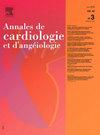Évaluation préliminaire de l'intérêt d'une cellule d'optimisation thérapeutique sur la titration des traitements de l'insuffisance cardiaque à fraction d’éjection ventriculaire gauche réduite et la qualité de vie des patients
IF 0.3
Q4 Medicine
引用次数: 0
Abstract
Introduction
A multidisciplinary therapeutic optimization unit (COT) was created in January 2023 at Versailles Hospital, aimed at therapeutic optimisation of patients with chronic heart failure with reduced left ventricular ejection fraction. The objective of the study was to assess the impact of the first year of COT activity on the sequential implementation and titration of heart failure treatments, the clinical evolution, and improvement of patients’ quality of life.
Methods
This prospective study included consecutive patients treated by the COT after hospitalisation for acute heart failure, from January to December 2023. Clinical, biological, titration, and tolerance data were analysed. Quality of life was assessed at baseline and at the end of the follow-up by COT, using standardized SF-12 and EQ-5D questionnaires.
Results
We included 90 patients (men 73%, mean age 67 years). The mean left ventricular ejection fraction was 34 ± 10 %. At final visit (median number of visits 4 ; median follow-up duration 156 days), 76.7% of patients achieved optimisation with respect to maximum individually tolerated doses, but only 13.3% with respect to theoretical maximum doses for the four therapeutic classes. At 1-year follow up, total mortality was 4.4% (4/90), and 9 patients (10%) were rehospitalised unplanned for acute heart failure. COT monitoring was associated with significant improvement in NYHA class, left ventricular ejection fraction, and SF-12 and EQ-5D-5L quality of life scores.
Conclusion
Although titration of heart failure treatments remained suboptimal, significant improvement was observed for NYHA class, left ventricular ejection fraction, and patient quality of life parameters.
初步评估治疗优化单元对左心室射血分数降低型心力衰竭滴定治疗和患者生活质量的益处
简介:2023年1月,凡尔赛医院成立了一个多学科治疗优化小组(COT),旨在对左心室射血分数降低的慢性心力衰竭患者进行治疗优化。这项前瞻性研究纳入了2023年1月至12月期间因急性心力衰竭住院后接受COT治疗的连续患者。研究分析了临床、生物、滴定和耐受性数据。结果我们纳入了90名患者(男性占73%,平均年龄67岁)。平均左心室射血分数为 34 ± 10%。在最后一次随访时(随访次数中位数为 4 次;随访时间中位数为 156 天),76.7% 的患者达到了个人可耐受的最大剂量,但只有 13.3% 的患者达到了四类疗法的理论最大剂量。在为期一年的随访中,总死亡率为 4.4%(4/90),9 名患者(10%)因急性心力衰竭意外再次住院。COT监测与NYHA分级、左心室射血分数以及SF-12和EQ-5D-5L生活质量评分的显著改善相关。
本文章由计算机程序翻译,如有差异,请以英文原文为准。
求助全文
约1分钟内获得全文
求助全文
来源期刊
CiteScore
0.60
自引率
0.00%
发文量
68
审稿时长
6-12 weeks
期刊介绍:
Organe scientifique de référence fondé en 1951, les Annales de cardiologie et d''angéiologie abordent tous les domaines qui intéressent quotidiennement les cardiologues et les angéiologues praticiens : neurologie et radiologie vasculaires, hémostase, diabétologie, médecine interne, épidémiologie et prévention.
Les Annales de cardiologie et d''angéiologie sont indexées aux grandes bases de données et publient rapidement, et en conformité avec les normes internationales de publication scientifique, des articles en français sur la pathologie cardiaque.

 求助内容:
求助内容: 应助结果提醒方式:
应助结果提醒方式:


